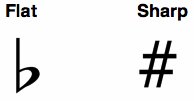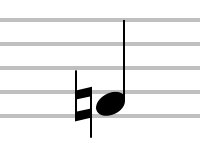Sharps and Flats
Flats and sharps are important in music because they tell us when a note or a tone is lowered or raised.
When a note goes down or gets lowered it is said to be flat. When a note is raised it is sharp.
For example, if a person is singing a song and the note they are to be singing is supposed to be a G, but they are slightly lower than that G they are said to be singing flat.
On the other hand if they were a bit higher than G they are said to be sharp.
Most people, when it comes to listening to pitch cant tell the difference in a sightly sharp or flat note. But when a note become to far flat or sharp it now becomes a new note.
When a note becomes lower in pitch by a semitone or “half step”, it is flat. The same goes for a note that is raised or higher by a half step is sharp.
Sharp and Flat Symbols
When a note or pitch is said to be flat it will be represented on musical notation with a symbol that is similar to a lower case b. When a note is sharp it will be represented by a symbol that looks like a number sign. Both a sharp and flat sign are pictured below.

Sharps and Flats in Music
To determine when to play these flats and sharps you have to look at the key signature. This tells you how many sharps and flats you have to play in that key.
For example, if you are in the key of G the staff paper will tell you that every time an F is to be played you must play an F# instead.
This is important because they don’t put the sharps and flats next to the notes every time they want you to play it. They will only put it at the beginning of each row so its important to remember what keys have certain sharps and certain flats.
Naturals
A natural is another symbol that you have to know.
A natural sign tells you when to take a note that is normally sharped or flatted and make it the natural note instead.
That doesn’t make any sense does it.
Lets do an example.
In the key of G there is one sharp, F#. So throughout that song you know that every time the music says to play an F that you have to play and F# instead.

Sometimes music has to break the rules. The music might want you to, one time in the song, to play an F instead of the F#. This is known as playing the natural.
All the white notes are naturals so the song puts a natural sign next to the F# note and that tells you to play an F instead.
Below is what a Natural Sign looks like.

Go From Sharps and Flats Back to Music Theory
Back to Home Page
